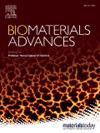间充质干细胞分泌组对电刷涂层钛合金反应的发现:突出了骨愈合相关因素的特定特征
IF 6
2区 医学
Q2 MATERIALS SCIENCE, BIOMATERIALS
Materials Science & Engineering C-Materials for Biological Applications
Pub Date : 2025-06-18
DOI:10.1016/j.bioadv.2025.214391
引用次数: 0
摘要
由于钛及其合金的生物相容性和力学性能,钛及其合金在种植体制造中的应用越来越多。但是,必须考虑到它们的生物惰性。表面修饰对于加速骨整合和骨愈合至关重要。本文采用电化学沉积技术将磷酸钙(刷石,CaHPO4.2H2O)沉积在添加剂制备的Ti6Al4V合金衬底上。x射线衍射(XRD)和傅里叶变换红外光谱(FTIR)证实了Ti6Al4V衬底上存在刷石。扫描电子显微镜(SEM)和横截面显微镜观察证实了涂层覆盖的均匀性,由约1-3 μm厚、10 μm长的微晶体组成。EDXS分析显示纯刷石的化学计量值,拉伸附着力测试显示与基体的附着力良好。该涂层在MES (pH 5.5)和HEPES (pH 7.4)缓冲溶液中溶解迅速。刷石包覆钛合金在成骨培养基中培养的人间充质干细胞(hMSCs)增殖正常,生物矿化增强,SP7 mRNA表达上调。为了探索刷石如何促进骨愈合,我们对与钛合金共培养7天和14天的hMSCs分泌组进行了基于液相色谱-串联质谱(LC-MS/MS)的蛋白质组学分析。刷石促进成骨因子和骨基质因子的分泌。参与血液凝固(如FII、FV、FX)、线粒体生物发生、能量代谢(如线粒体ATP合成酶)、脂质代谢(如载脂蛋白)和细胞应激反应(如热休克蛋白)的因子得到了富集。特异性染色质相关蛋白的增加表明染色质在促进骨再生中的作用。分泌组分析显示刷石钛合金在骨再生中的独特作用,鼓励进一步的研究。本文章由计算机程序翻译,如有差异,请以英文原文为准。

Mesenchymal stem cell secretome discovery in response to a brushite-coated titanium alloy: highlighted a specific signature of factors involved in bone healing
Increased use of titanium (Ti) and its alloys in implant manufacture is due to their biocompatibility and mechanical properties. However, their biological inertness must be considered. Surface modifications are essential for accelerating osteointegration and bone healing. Herein, calcium phosphate (brushite, CaHPO4.2H2O) was deposited on an additive-manufactured Ti6Al4V alloy substrate by electrochemical deposition technique. X-ray diffraction (XRD) and Fourier transform infrared (FTIR) spectroscopy confirmed the presence of brushite on the Ti6Al4V substrate. Scanning electron microscopy (SEM) and cross-section micrograph observations confirmed the homogeneity of the coating's coverage, composed of microcrystals approximately 1–3 μm thick and 10 μm long. EDXS analysis revealed pure brushite stoichiometric values, and tensile adhesion tests demonstrated good adhesion to the substrate. The coating demonstrated a rapid dissolution in MES (pH 5.5) and HEPES (pH 7.4) buffer solutions. Human mesenchymal stem cells (hMSCs) cultured with brushite-coated Ti alloy in osteogenic medium showed normal proliferation and increased biomineralization with SP7 mRNA upregulation. To explore how Brushite improved bone healing, we performed liquid chromatography-tandem mass spectrometry (LC-MS/MS)-based proteomics analysis of hMSCs secretome from co-cultures with Ti alloys, for 7 and 14 days. Brushite promoted secretion of osteogenic and bone matrix factors. Factors involved in blood clotting (e.g. FII, FV, FX), mitochondrial biogenesis, energy metabolism (e.g. mitochondrial ATP synthase), lipid metabolism (e.g. apolipoproteins) and cellular stress response (e.g. heat shock proteins) were enriched. Increased specific chromatin-related proteins suggest chromatin's role in enhancing bone regeneration. Secretome profiling showed the unique role of brushite Ti alloys in bone regeneration, encouraging further study.
求助全文
通过发布文献求助,成功后即可免费获取论文全文。
去求助
来源期刊
CiteScore
17.80
自引率
0.00%
发文量
501
审稿时长
27 days
期刊介绍:
Biomaterials Advances, previously known as Materials Science and Engineering: C-Materials for Biological Applications (P-ISSN: 0928-4931, E-ISSN: 1873-0191). Includes topics at the interface of the biomedical sciences and materials engineering. These topics include:
• Bioinspired and biomimetic materials for medical applications
• Materials of biological origin for medical applications
• Materials for "active" medical applications
• Self-assembling and self-healing materials for medical applications
• "Smart" (i.e., stimulus-response) materials for medical applications
• Ceramic, metallic, polymeric, and composite materials for medical applications
• Materials for in vivo sensing
• Materials for in vivo imaging
• Materials for delivery of pharmacologic agents and vaccines
• Novel approaches for characterizing and modeling materials for medical applications
Manuscripts on biological topics without a materials science component, or manuscripts on materials science without biological applications, will not be considered for publication in Materials Science and Engineering C. New submissions are first assessed for language, scope and originality (plagiarism check) and can be desk rejected before review if they need English language improvements, are out of scope or present excessive duplication with published sources.
Biomaterials Advances sits within Elsevier''s biomaterials science portfolio alongside Biomaterials, Materials Today Bio and Biomaterials and Biosystems. As part of the broader Materials Today family, Biomaterials Advances offers authors rigorous peer review, rapid decisions, and high visibility. We look forward to receiving your submissions!

 求助内容:
求助内容: 应助结果提醒方式:
应助结果提醒方式:


